80N as the Optimal Assistive Threshold for Wearable Exoskeleton-Mediated Gait Rehabilitation in Parkinson’s Disease: A Prospective Biomarker Validation Study
Abstract
1. Introduction
2. Materials and Methods
2.1. Clinical Material
2.2. Method
2.2.1. Pre-Gait Training Preparations
2.2.2. Exoskeleton System Operation and Assistance Mechanisms
2.2.3. Monitoring Paradigms and Gait Parameter Collection with the Exoskeleton
2.3. Observation Indicators and Evaluation Methods
2.4. Statistical Methods
3. Results
3.1. Reliability and Validity Test
3.2. Clinical Correlation Analysis
3.3. Determination of Optimal Assistive Force Parameters Through Random Intervention
4. Discussion
5. Conclusions
Supplementary Materials
Author Contributions
Funding
Institutional Review Board Statement
Informed Consent Statement
Data Availability Statement
Acknowledgments
Conflicts of Interest
Abbreviations
| PD | Parkinson’s Disease |
| UPDRS-III | Unified Parkinson’s Disease Rating Scale Part III |
| ROC | Receiver Operating Characteristic |
| AUC | Area Under the Curve |
| LLexo | Lower Limb Exoskeleton |
| OFF | Levodopa Challenge Test-Pre |
| ON | Levodopa Challenge Test-Post |
| LCT | Levodopa Challenge Test |
| M-H&Y | Modified Hoehn and Yahr Scale |
| MMSE | Mini-Mental State Examination |
| MoCA | Montreal Cognitive Assessment |
| IMU | Inertial Measurement Unit |
| AFO | Ankle-Foot Orthosis |
| BMI | Body Mass Index |
| PID | Proportional-Integral-Derivative |
| EMG | Electromyography |
| 10 MWT | 10-Meter Walk Test |
| TUG | Timed Up and Go Test |
References
- Mirelman, A.; Bonato, P.; Camicioli, R.; Ellis, T.D.; Giladi, N.; Hamilton, J.L.; Hass, C.J.; Hausdorff, J.M.; Pelosin, E.; Almeida, Q.J. Gait impairments in Parkinson’s disease. Lancet Neurol. 2019, 18, 697–708. [Google Scholar] [CrossRef] [PubMed]
- Peterson, D.S.; Horak, F.B. Neural Control of Walking in People with Parkinsonism. Physiology 2016, 31, 95–107. [Google Scholar] [CrossRef] [PubMed]
- Bloem, B.R.; Grimbergen, Y.A.; Cramer, M.; Willemsen, M.; Zwinderman, A.H. Prospective assessment of falls in Parkinson’s disease. J. Neurol. 2001, 248, 950–958. [Google Scholar] [CrossRef] [PubMed]
- Yoritaka, A.; Shimo, Y.; Takanashi, M.; Fukae, J.; Hatano, T.; Nakahara, T.; Miyamato, N.; Urabe, T.; Mori, H.; Hattori, N. Motor and non-motor symptoms of 1453 patients with Parkinson’s disease: Prevalence and risks. Park. Relat. Disord. 2013, 19, 725–731. [Google Scholar] [CrossRef]
- Snijders, A.H.; van de Warrenburg, B.P.; Giladi, N.; Bloem, B.R. Neurological gait disorders in elderly people: Clinical approach and classification. Lancet Neurol. 2007, 6, 63–74. [Google Scholar] [CrossRef]
- Kobayashi, E.; Himuro, N.; Takahashi, M. Clinical utility of the 6-min walk test for patients with moderate Parkinson’s disease. Int. J. Rehabil. Res. 2017, 40, 66–70. [Google Scholar] [CrossRef]
- Mancini, M.; Bloem, B.R.; Horak, F.B.; Lewis, S.J.G.; Nieuwboer, A.; Nonnekes, J. Clinical and methodological challenges for assessing freezing of gait: Future perspectives. Mov. Disord. 2019, 34, 783–790. [Google Scholar] [CrossRef]
- Golbe, L.I.; Pae, J. Validity of a mailed epidemiological questionnaire and physical self-assessment in Parkinson’s disease. Mov. Disord. 1988, 3, 245–254. [Google Scholar] [CrossRef]
- Smith, M.D.; Brazier, D.E.; Henderson, E.J. Current Perspectives on the Assessment and Management of Gait Disorders in Parkinson’s Disease. Neuropsychiatr. Dis. Treat. 2021, 17, 2965–2985. [Google Scholar] [CrossRef]
- Church, F.C. Treatment Options for Motor and Non-Motor Symptoms of Parkinson’s Disease. Biomolecules 2021, 11, 612. [Google Scholar] [CrossRef]
- Gronek, P.; Haas, A.N.; Czarny, W.; Podstawski, R.; Delabary, M.D.S.; Clark, C.C.; Boraczyński, M.; Tarnas, M.; Wycichowska, P.; Pawlaczyk, M.; et al. The Mechanism of Physical Activity-induced Amelioration of Parkinson’s Disease: A Narrative Review. Aging Dis. 2021, 12, 192–202. [Google Scholar] [CrossRef] [PubMed]
- Rodríguez, M.; Albillos-Almaraz, L.; López-Aguado, I.; Crespo, I.; Del Valle, M.; Olmedillas, H. Vigorous Aerobic Exercise in the Management of Parkinson Disease: A Systematic Review. PM&R 2021, 13, 890–900. [Google Scholar] [CrossRef]
- Petzinger, G.M.; Fisher, B.E.; McEwen, S.; Beeler, J.A.; Walsh, J.P.; Jakowec, M.W. Exercise-enhanced neuroplasticity targeting motor and cognitive circuitry in Parkinson’s disease. Lancet Neurol. 2013, 12, 716–726. [Google Scholar] [CrossRef] [PubMed]
- Goodwin, V.A.; Richards, S.H.; Taylor, R.S.; Taylor, A.H.; Campbell, J.L. The effectiveness of exercise interventions for people with Parkinson’s disease: A systematic review and meta-analysis. Mov. Disord. 2008, 23, 631–640. [Google Scholar] [CrossRef]
- Zotaj, A.; Milloshi, R.; Sokoli, S.; Doci, H. Effectiveness of physiotherapy rehabilitation approaches for Parkinson’s disease: A Durrës case study. Physiother. Res. Int. 2024, 29, e2124. [Google Scholar] [CrossRef]
- Alberts, S.; Wolmarans, M.; Mohamed, N.; Jalal, A.H.; Noorbhai, H. Level of memory contentment and ability among Parkinson’s disease patients partaking in Biokinetics exercise rehabilitation: A South African exploratory study. Cogent Psychol. 2024, 11, 2390275. [Google Scholar] [CrossRef]
- Ahlskog, J.E. Does vigorous exercise have a neuroprotective effect in Parkinson disease? Neurology 2011, 77, 288–294. [Google Scholar] [CrossRef]
- Fox, C.M.; Ramig, L.O.; Ciucci, M.R.; Sapir, S.; McFarland, D.H.; Farley, B.G. The science and practice of LSVT/LOUD: Neural plasticity-principled approach to treating individuals with Parkinson disease and other neurological disorders. Semin. Speech Lang. 2006, 27, 283–299. [Google Scholar] [CrossRef]
- Rahman, S.; Sarker, S.; Haque, A.K.M.N.; Uttsha, M.M.; Islam, M.F.; Deb, S. AI-Driven Stroke Rehabilitation Systems and Assessment: A Systematic Review. IEEE Trans. Neural Syst. Rehabil. Eng. 2023, 31, 192–207. [Google Scholar] [CrossRef]
- Ai, Q.; Liu, Z.; Meng, W.; Liu, Q.; Xie, S.Q. Machine Learning in Robot-Assisted Upper Limb Rehabilitation: A Focused Review. IEEE Trans. Cogn. Dev. Syst. 2021, 15, 2053–2063. [Google Scholar] [CrossRef]
- Jadhwani, P.L.; Harjpal, P. A Review of Artificial Intelligence-Based Gait Evaluation and Rehabilitation in Parkinson’s Disease. Cureus 2023, 15, e47118. [Google Scholar] [CrossRef] [PubMed]
- Brzenczek, C.; Klopfenstein, Q.; Hähnel, T.; Fröhlich, H.; Glaab, E. Integrating digital gait data with metabolomics and clinical data to predict outcomes in Parkinson’s disease. NPJ Digit. Med. 2024, 7, 235. [Google Scholar] [CrossRef] [PubMed]
- Carmignano, S.M.; Fundarò, C.; Bonaiuti, D.; Calabrò, R.S.; Cassio, A.; Mazzoli, D.; Bizzarini, E.; Campanini, I.; Cerulli, S.; Chisari, C.; et al. Robot-assisted gait training in patients with Parkinson’s disease: Implications for clinical practice. A systematic review. NeuroRehabilitation 2022, 51, 649–663. [Google Scholar] [CrossRef] [PubMed]
- Wu, P.; Cao, B.; Liang, Z.; Wu, M. The advantages of artificial intelligence-based gait assessment in detecting, predicting, and managing Parkinson’s disease. Front. Aging Neurosci. 2023, 15, 1191378. [Google Scholar] [CrossRef]
- Gryfe, P.; Sexton, A.; McGibbon, C.A. Using gait robotics to improve symptoms of Parkinson’s disease: An open-label, pilot randomized controlled trial. Eur. J. Phys. Rehabil. Med. 2022, 58, 723–737. [Google Scholar] [CrossRef]
- Esquenazi, A.; Talaty, M.; Packel, A.; Saulino, M. The ReWalk powered exoskeleton to restore ambulatory function to individuals with thoracic-level motor-complete spinal cord injury. Am. J. Phys. Med. Rehabil. 2012, 91, 911–921. [Google Scholar] [CrossRef]
- Alcobendas-Maestro, M.; Esclarín-Ruz, A.; Casado-López, R.M.; Muñoz-González, A.; Pérez-Mateos, G.; González-Valdizán, E.; Martín, J.L. Lokomat robotic-assisted versus overground training within 3 to 6 months of incomplete spinal cord lesion: Randomized controlled trial. Neurorehabilit. Neural Repair 2012, 26, 1058–1063. [Google Scholar] [CrossRef]
- Si, G.; Huang, W.; Li, G.; Xu, F.; Chu, M.; Liu, J. Research progress on compliant characteristics of lower extremity exoskeleton robots. J. Biomed. Eng. 2019, 36, 157–163. [Google Scholar] [CrossRef]
- Chen, B.; Ma, H.; Qin, L.Y.; Gao, F.; Chan, K.M.; Law, S.W.; Qin, L.; Liao, W.H. Recent developments and challenges of lower extremity exoskeletons. J. Orthop. Transl. 2016, 5, 26–37. [Google Scholar] [CrossRef]
- Kim, S. Adelic Rogers integral formula. J. Lond. Math. Soc. 2024, 109, e12830. [Google Scholar] [CrossRef]
- Boonstra, T.A.; van der Kooij, H.; Munneke, M.; Bloem, B.R. Gait disorders and balance disturbances in Parkinson’s disease: Clinical update and pathophysiology. Curr. Opin. Neurol. 2008, 21, 461–471. [Google Scholar] [CrossRef] [PubMed]
- Milia, P.; Salvo, F.; Caserio, M.; Cope, T.; Weber, P.; Santella, C.; Fiorini, S.; Baldoni, G.; Bruschi, R.; Bigazzi, B.; et al. Neurorehabilitation in paraplegic patients with an active powered exoskeleton (Ekso). Digit. Med. 2016, 2, 163. [Google Scholar] [CrossRef]
- Karunakaran, K.K.; Pamula, S.D.; Bach, C.P.; Legelen, E.; Saleh, S.; Nolan, K.J. Lower extremity robotic exoskeleton devices for overground ambulation recovery in acquired brain injury-A review. Front. Neurorobot. 2023, 17, 1014616. [Google Scholar] [CrossRef] [PubMed]
- Kawashima, N.; Hasegawa, K.; Iijima, M.; Nagami, K.; Makimura, T.; Kumon, A.; Ohtsuki, S. Efficacy of Wearable Device Gait Training on Parkinson’s Disease: A Randomized Controlled Open-label Pilot Study. Intern. Med. 2022, 61, 2573–2580. [Google Scholar] [CrossRef]
- McGibbon, C.A.; Sexton, A.; Gryfe, P. Exercising with a robotic exoskeleton can improve memory and gait in people with Parkinson’s disease by facilitating progressive exercise intensity. Sci. Rep. 2024, 14, 4417. [Google Scholar] [CrossRef]
- Kang, M.G.; Yun, S.J.; Shin, H.I.; Kim, E.; Lee, H.H.; Oh, B.M.; Seo, H.G. Effects of robot-assisted gait training in patients with Parkinson’s disease: Study protocol for a randomized controlled trial. Trials 2019, 20, 15. [Google Scholar] [CrossRef]
- Picelli, A.; Melotti, C.; Origano, F.; Waldner, A.; Fiaschi, A.; Santilli, V.; Smania, N. Robot-assisted gait training in patients with Parkinson disease: A randomized controlled trial. Neurorehabilit. Neural Repair 2012, 26, 353–361. [Google Scholar] [CrossRef]
- Kegelmeyer, D.A.; Minarsch, R.; Kostyk, S.K.; Kline, D.; Smith, R.; Kloos, A.D. Use of a Robotic Walking Device for Home and Community Mobility in Parkinson Disease: A Randomized Controlled Trial. J. Neurol. Phys. Ther. 2024, 48, 102–111. [Google Scholar] [CrossRef]
- Kim, J.; Porciuncula, F.; Yang, H.D.; Wendel, N.; Baker, T.; Chin, A.; Ellis, T.D.; Walsh, C.J. Soft robotic apparel to avert freezing of gait in Parkinson’s disease. Nat. Med. 2024, 30, 177–185. [Google Scholar] [CrossRef]
- Sun, Y.; Liu, P.; Yang, Y.; Yu, Y.; Yu, H.; Sun, X.; Wu, J.; Han, J.; Yu, N. A two-dimensional video based quantification method and clinical application research of motion disorders. J. Biomed. Eng. 2023, 40, 499–507. [Google Scholar] [CrossRef]
- Nardo, A.; Anasetti, F.; Servello, D.; Porta, M. Quantitative gait analysis in patients with Parkinson treated with deep brain stimulation: The effects of a robotic gait training. NeuroRehabilitation 2014, 35, 779–788. [Google Scholar] [CrossRef] [PubMed]
- Kluger, B.M.; Katz, M.; Galifianakis, N.B.; Pantilat, S.Z.; Hauser, J.M.; Khan, R.; Friedman, C.; Vaughan, C.L.; Goto, Y.; Long, S.J.; et al. Patient and Family Outcomes of Community Neurologist Palliative Education and Telehealth Support in Parkinson Disease. JAMA Neurol. 2024, 81, 39–49. [Google Scholar] [CrossRef] [PubMed]
- Chastan, N.; Do, M.C.; Bonneville, F.; Torny, F.; Bloch, F.; Westby, G.W.; Dormont, D.; Agid, Y.; Welter, M.L. Gait and balance disorders in Parkinson’s disease: Impaired active braking of the fall of centre of gravity. Mov. Disord. 2009, 24, 188–195. [Google Scholar] [CrossRef]
- Conway, Z.J.; Silburn, P.A.; Perera, T.; O’Maley, K.; Cole, M.H. Low-frequency STN-DBS provides acute gait improvements in Parkinson’s disease: A double-blinded randomised cross-over feasibility trial. J. Neuroeng. Rehabil. 2021, 18, 125. [Google Scholar] [CrossRef]
- Schlachetzki, J.C.M.; Barth, J.; Marxreiter, F.; Gossler, J.; Kohl, Z.; Reinfelder, S.; Gassner, H.; Aminian, K.; Eskofier, B.M.; Winkler, J.; et al. Wearable sensors objectively measure gait parameters in Parkinson’s disease. PLoS ONE 2017, 12, e0183989. [Google Scholar] [CrossRef]
- Ibrahim, N.E.-S. Soft robotic apparel improves walking in Parkinson’s disease. Nat. Rev. Bioeng. 2024, 2, 100. [Google Scholar] [CrossRef]
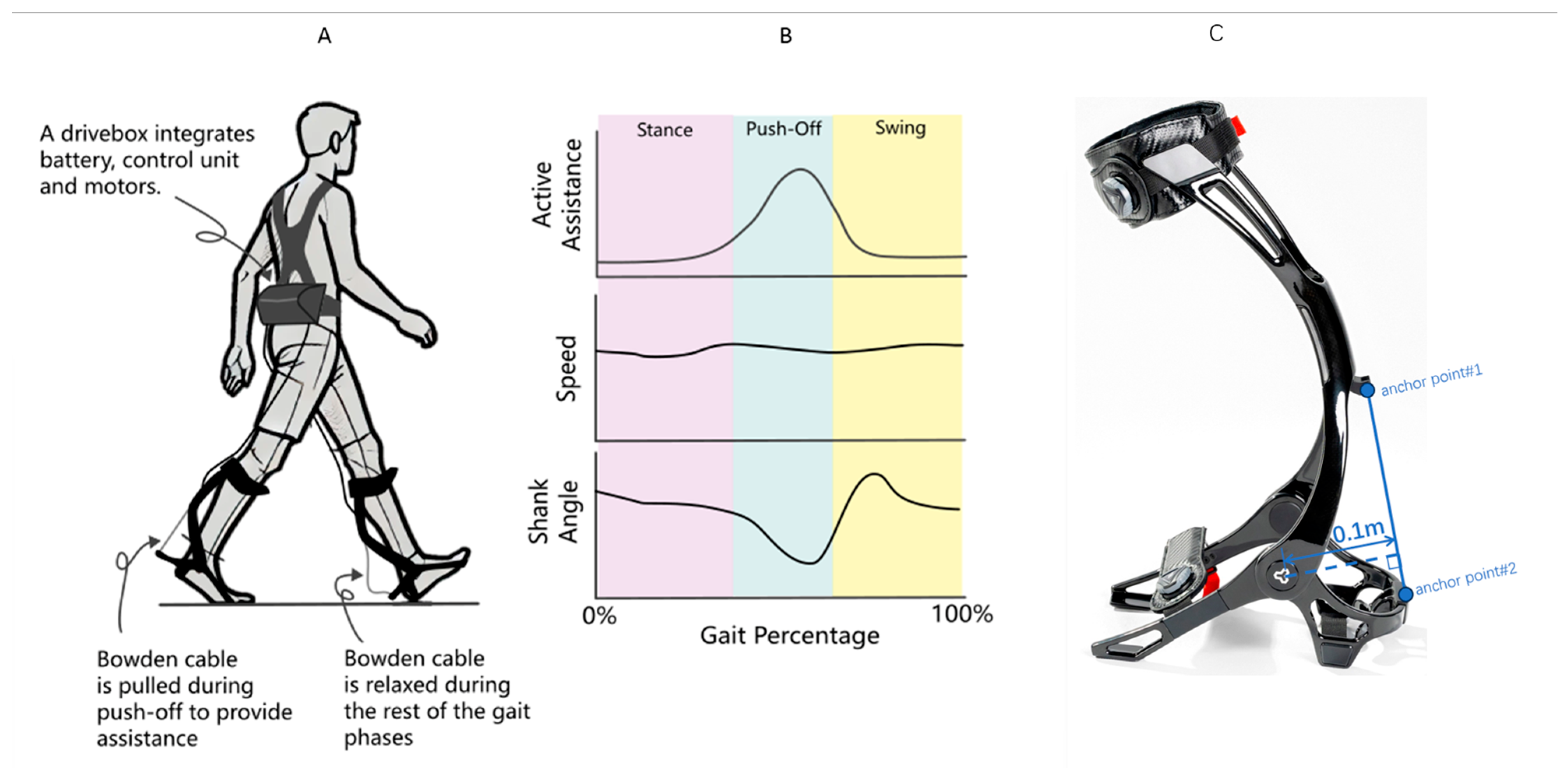
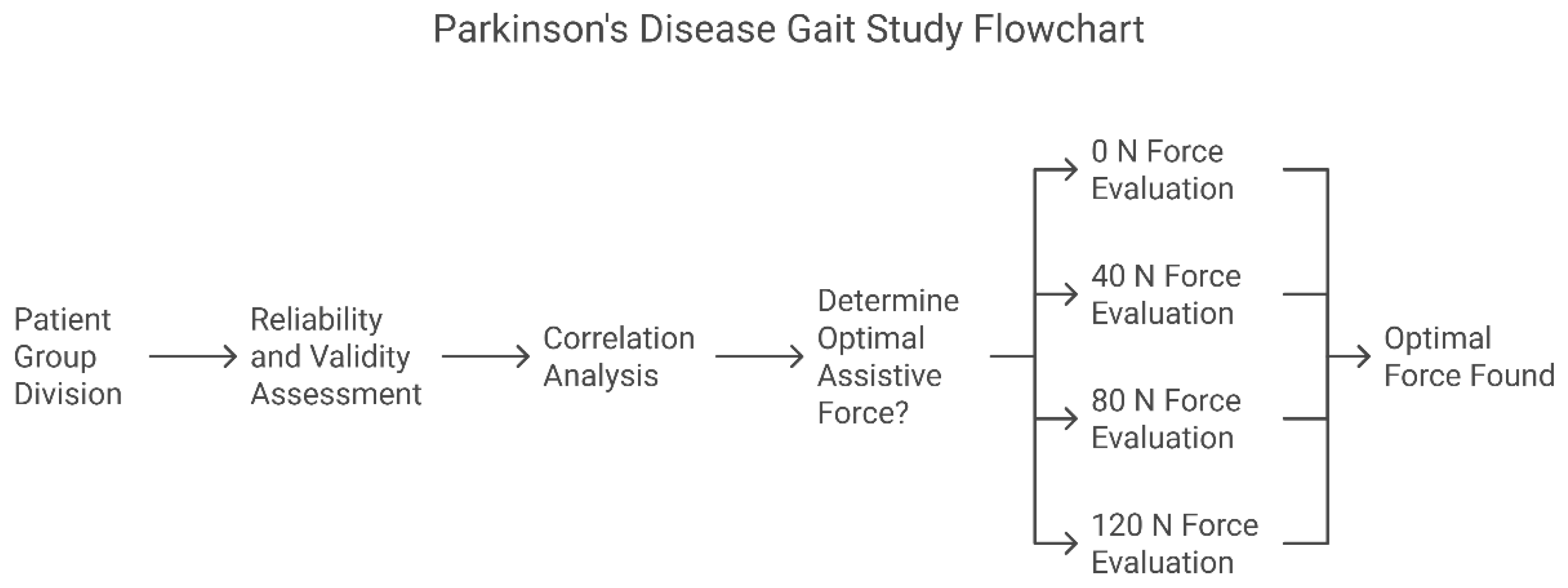
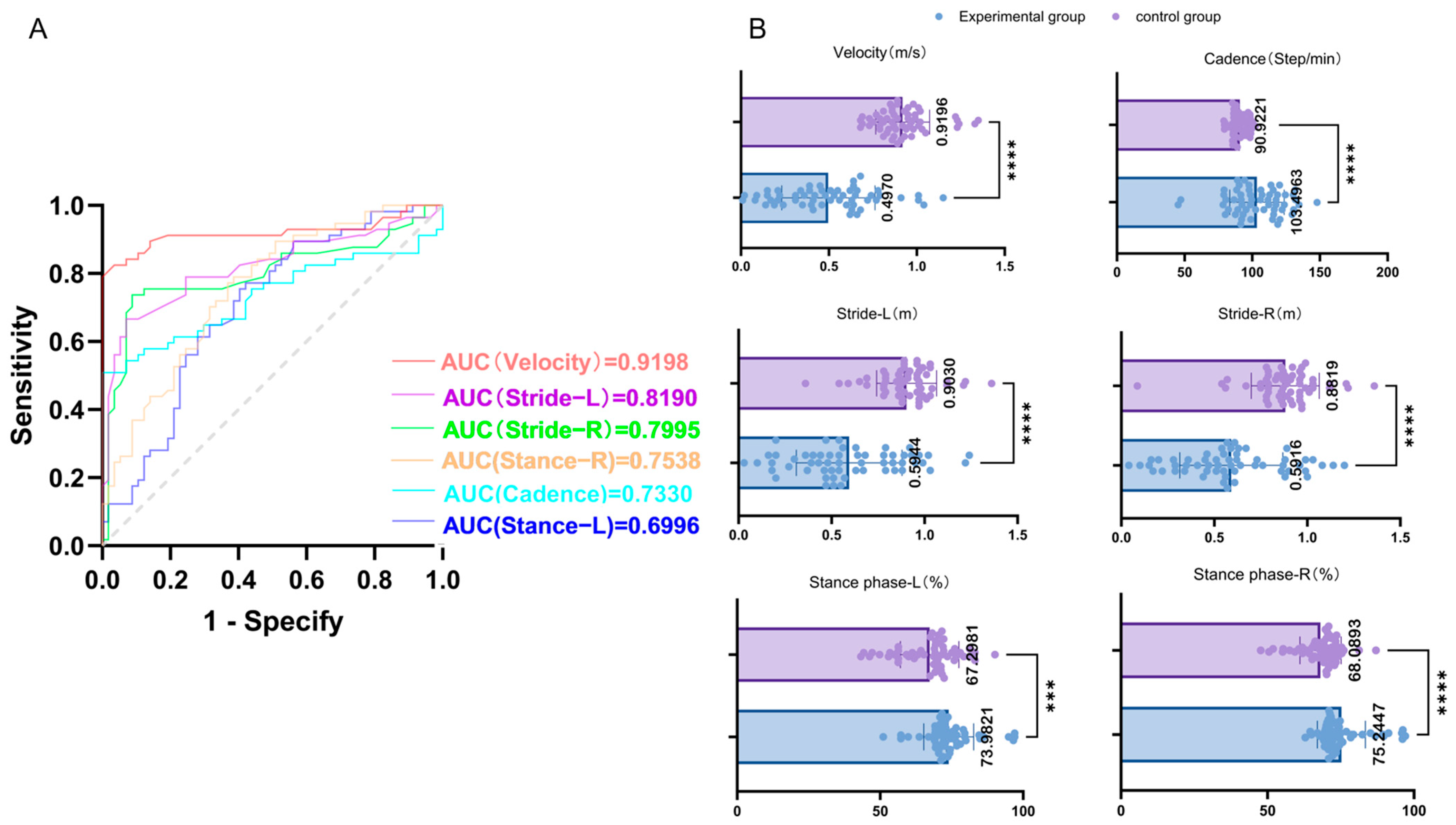
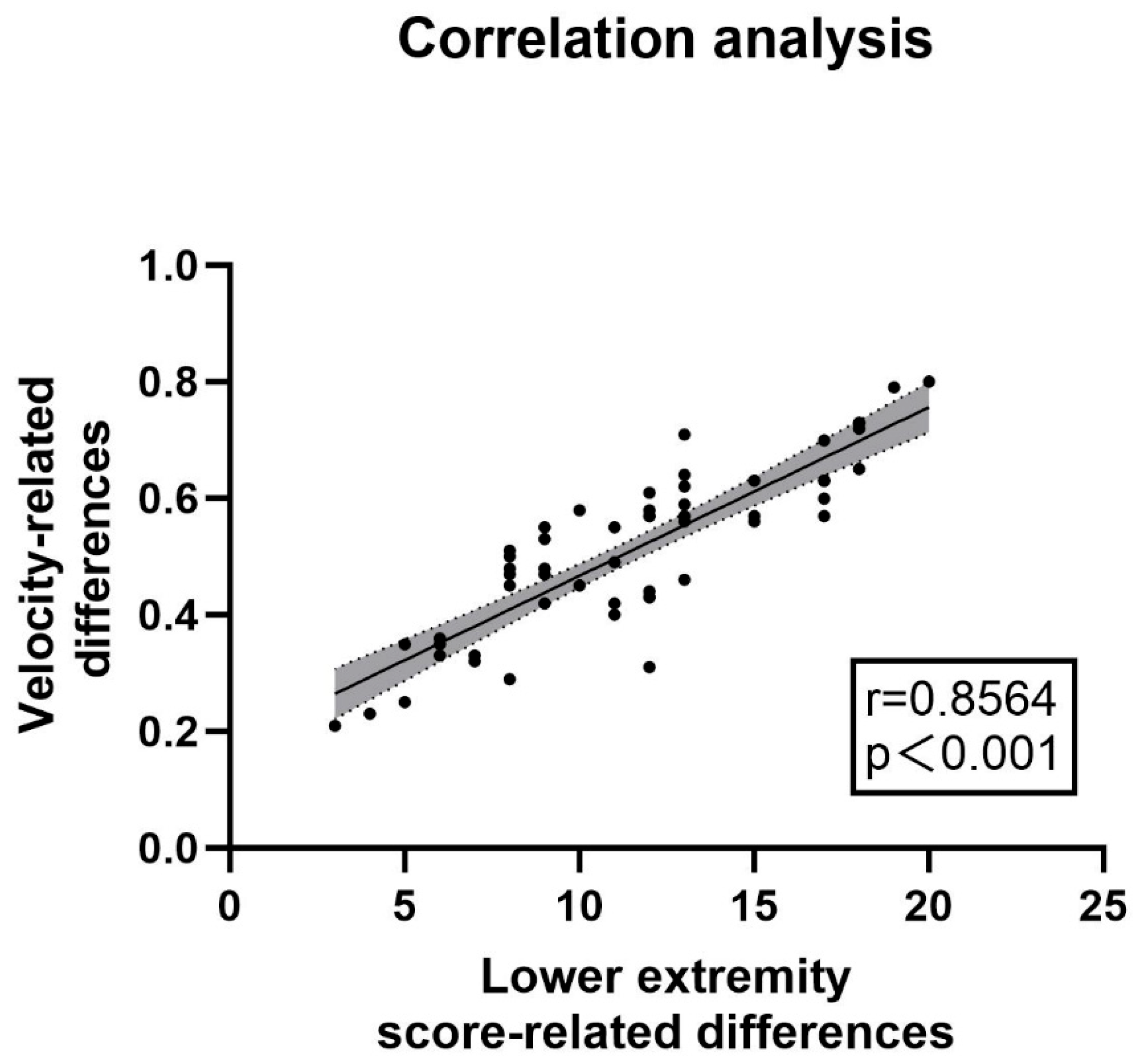
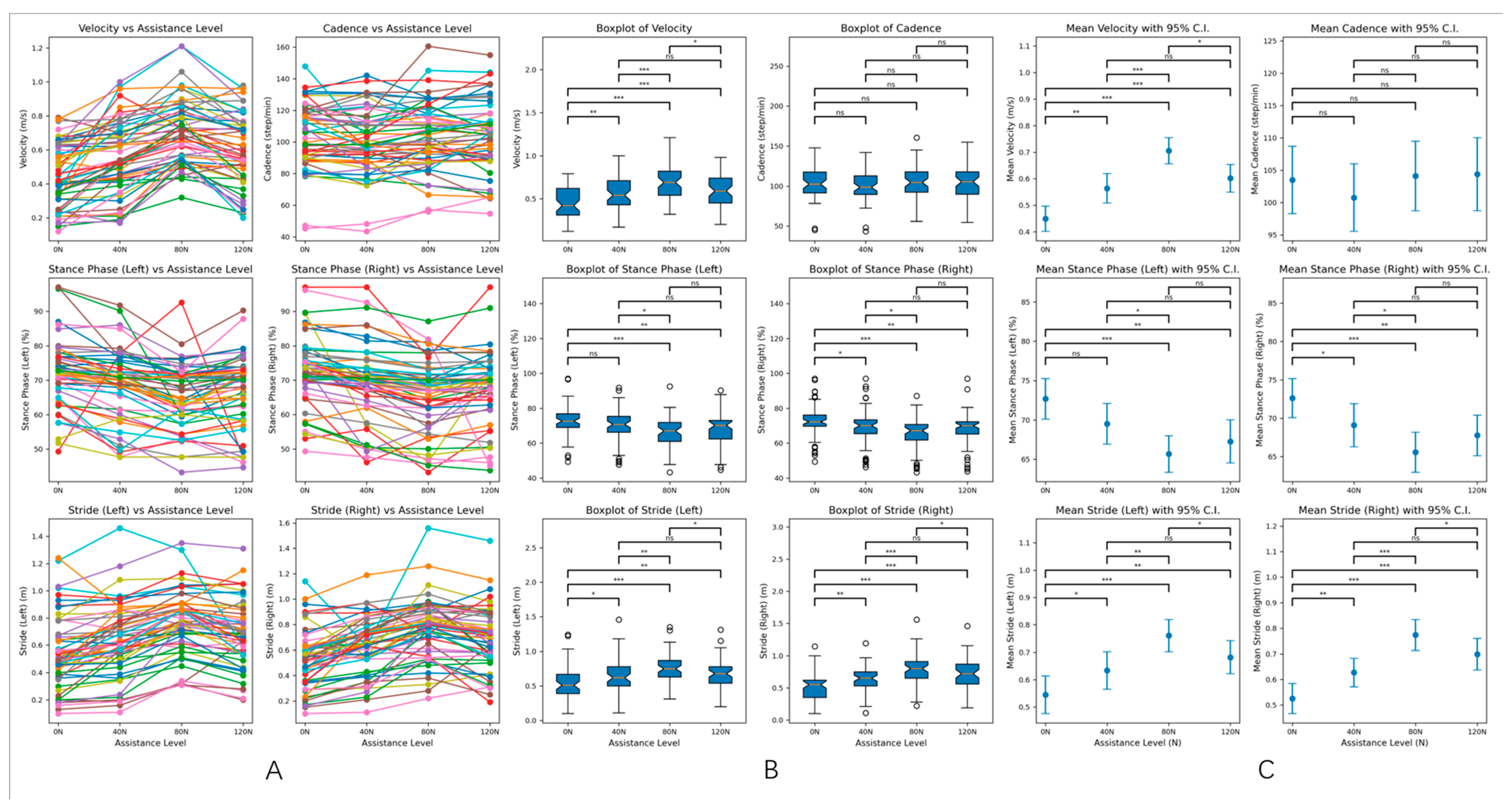
| Group | Experimental Group | Control Group | p |
|---|---|---|---|
| Age (years) | 61.82 ± 10.01 | 61.63 ± 8.91 | >0.05 |
| Duration of disease (years) | 6 (5, 7) | / | / |
| M-H&Y | 3.28 (2.76, 3.90) | / | / |
| UPDRS-III (OFF) | 46.18 ± 12.63 | / | / |
| UPDRS-III (ON) | 22.23 ± 6.71 | / | / |
| LCT Improvement Rate (%) | 51.77 ± 7.39 | / | / |
| Limb Side | Experimental Group | Control Group | p | |
|---|---|---|---|---|
| Velocity (m/s) | / | 0.50 ± 0.27 | 0.89 (0.82, 0.99) | **** |
| Cadence (steps/min) | / | 103.50 ± 20.10 | 90.92 ± 5.96 | **** |
| Stride (m) | Left | 0.59 ± 0.28 | 0.91 (0.82, 0.98) | **** |
| Right | 0.59 ± 0.28 | 0.89 (0.79, 0.97) | **** | |
| Stance phase (%) | Left | 72.64 (70.41, 76.80) | 69.36 (60.61, 72.28) | *** |
| Right | 72.25 (70.63, 76.28) | 69.78 (65.28, 71.85) | **** |
| OFF | ON | p | |||
|---|---|---|---|---|---|
| Number | 57 | / | / | ||
| Gender (Men/Women) | 33/24 | / | / | ||
| Age (years) | 61.82 ± 10.01 | / | / | ||
| Duration of disease (years) | 6.24 (5.17, 7.36) | / | / | ||
| UPDRS-III score | 46.18 ± 12.63 | 22.23 ± 6.71 | *** | ||
| LLexo Motion Monitoring | Velocity (m/s) | 0.41 (0.31, 0.51) | 0.94 (0.87, 0.98) | *** | |
| Stride(m) | Left | 0.59 ± 0.28 | 0.68 ± 0.28 | ** | |
| Right | 0.59 ± 0.27 | 0.69 ± 0.29 | ** | ||
| Stance phase (%) | Left | 72.35 (64.65, 78.83) | 70.58 (61.03, 75.12) | ** | |
| Right | 71.93 (66.57, 75.59) | 70.32 (61.11, 73.97) | ** | ||
| Parameter | 0 N | 40 N | 80 N | 120 N | p | |
|---|---|---|---|---|---|---|
| Velocity(m/s) | / | 0.45 ± 0.18 | 0.56 ± 0.21 | 0.71 ± 0.19 | 0.60 ± 0.20 | *** |
| Cadence (Steps/min) | / | 103.50 ± 20.10 | 100.77 ± 20.13 | 104.11 ± 20.70 | 104.39 ± 21.77 | ns |
| Stride(m) | Left | 0.59 ± 0.28 | 0.63 ± 0.29 | 0.68 ± 0.28 | 0.67 ± 0.29 | * |
| Right | 0.53 ± 0.23 | 0.63 ± 0.22 | 0.77 ± 0.23 | 0.70 ± 0.24 | ** | |
| Stance phase (%) | Left | 72.64 (69.24, 75.89) | 70.21 (64.97, 72.47) | 64.23 (60.58, 71.29) | 68.35 (62.37, 72.34) | ** |
| Right | 72.22 (69.45, 76.51) | 70.05 (64.72, 73.55) | 67.14 (60.74, 71.08) | 69.97 (64.72, 72.31) | *** |
Disclaimer/Publisher’s Note: The statements, opinions and data contained in all publications are solely those of the individual author(s) and contributor(s) and not of MDPI and/or the editor(s). MDPI and/or the editor(s) disclaim responsibility for any injury to people or property resulting from any ideas, methods, instructions or products referred to in the content. |
© 2025 by the authors. Licensee MDPI, Basel, Switzerland. This article is an open access article distributed under the terms and conditions of the Creative Commons Attribution (CC BY) license (https://creativecommons.org/licenses/by/4.0/).
Share and Cite
Wei, X.; Sun, J.; Lu, G.; Liu, J.; Yan, J.; Wei, X.; Cai, H.; Luo, B.; Dong, W.; Zhao, L.; et al. 80N as the Optimal Assistive Threshold for Wearable Exoskeleton-Mediated Gait Rehabilitation in Parkinson’s Disease: A Prospective Biomarker Validation Study. Healthcare 2025, 13, 799. https://doi.org/10.3390/healthcare13070799
Wei X, Sun J, Lu G, Liu J, Yan J, Wei X, Cai H, Luo B, Dong W, Zhao L, et al. 80N as the Optimal Assistive Threshold for Wearable Exoskeleton-Mediated Gait Rehabilitation in Parkinson’s Disease: A Prospective Biomarker Validation Study. Healthcare. 2025; 13(7):799. https://doi.org/10.3390/healthcare13070799
Chicago/Turabian StyleWei, Xiang, Jian Sun, Guanghan Lu, Jingxuan Liu, Jiuqi Yan, Xiong Wei, Hongyang Cai, Bei Luo, Wenwen Dong, Liang Zhao, and et al. 2025. "80N as the Optimal Assistive Threshold for Wearable Exoskeleton-Mediated Gait Rehabilitation in Parkinson’s Disease: A Prospective Biomarker Validation Study" Healthcare 13, no. 7: 799. https://doi.org/10.3390/healthcare13070799
APA StyleWei, X., Sun, J., Lu, G., Liu, J., Yan, J., Wei, X., Cai, H., Luo, B., Dong, W., Zhao, L., Qiu, C., Zhang, W., & Pan, Y. (2025). 80N as the Optimal Assistive Threshold for Wearable Exoskeleton-Mediated Gait Rehabilitation in Parkinson’s Disease: A Prospective Biomarker Validation Study. Healthcare, 13(7), 799. https://doi.org/10.3390/healthcare13070799






